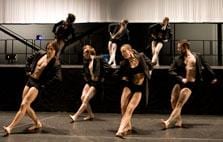The academic tendency to overexplain and theorize the inner workings of art and artists can be an annoying bit of stage business when it makes its way to a final production. The age-old theatre maxim, “Show, don’t tell,” often springs to mind when confronted with too much explication and not enough action. In the recent dance/theatre production of Darcey Callison’s (Re) Tracing Fred, the choreographer’s first major work in years, a fine line was created between entertainment and academia. For the most part both sides came out winners in a mesmerizing pastiche of Hollywood spectacle, mixed with contemporary dance gestures regarding the history of choreographed movement as it relates to masculinity.
Screen images of nostalgic dance footage were ingeniously mixed with live ensemble work. Running the gamut from spoken lines borrowed from Edward Albee to sign language and interaction with a projected scene from a classic Fred Astaire musical, the show was a demanding, nonstop physical display of diverse sight and sound.
Callison’s experience as a young male dancer, surrounded by mostly female students, motivated this very eclectic exploration of what he calls, “The layered traces of Hollywood’s danced movement vocabulary for men and an inquiry into how the movement, gestures, postures, steps and choreographic phrases of Hollywood’s leading male dancers inform the bodies of the seven contemporary dancers.”
One of the most intriguing aspects of the production was the presence of three female dancers taking on decidedly masculine personas through the use of similar costuming and T-shirts with male signifiers like “dude,” “boy” and “stud” emblazoned across them.
Although there were moments when the screen images overwhelmed the dancers, there were other breathtaking moments when the interaction between a live dancer and a projected Astaire made a thrilling and satisfying multimedia experience. The stagecraft was impeccable, with gorgeous evocative lighting by Elizabeth Asseistine and technical direction by Matt Armour. Barb Starr’s costume designs stated simply and clearly the narrative force behind the masculinized movement.
There were moments when the choreography might have been sharper, less gestural and ponderous, with perhaps a bit of tap thrown in to punctuate the recorded sound of tapping feet and the obvious presence of Astaire’s immense skill in this area. Nevertheless the dancers provided an impressive ensemble without a single weak link in a chain of highly interactive and complex movement, beginning with an almost knot-like exploration of physical prowess and ending with whispered allusions to Albee’s Zoo Story, enhanced by fluid dancerly versions of sign language.
From Astaire and Gene Kelly to John Travolta, Patrick Swayze and Gregory Hines, Hollywood history has given us a varied bevy of gorgeous guys who dared take on the feminized “sport” of dance. (Re) Tracing Fred is a bold and beautiful venture into masculinity that might have explored further the underlying feyness of a famous dancer who, despite gender ambiguity, made his way to the top of mainstream cinema’s dance musical craze. Indeed Callison’s ensemble of both male and female artists proves beyond the shadow of a doubt that, “Ginger Rogers did everything Fred Astaire did, except backward and in high heels.” And what could be more butch than that?
(Re) Tracing Fred was presented at York University’s Sandra Faire and Ivan Fecan Theatre from Feb 24 to 28.

 Why you can trust Xtra
Why you can trust Xtra


